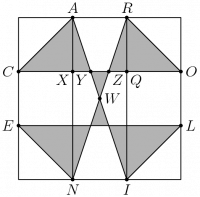Difference between revisions of "2018 AIME II Problems/Problem 4"
(If anyone is good with Asymptote, please change the diagrams because I am not good with Asymptote at all) |
(→Problem) |
||
| Line 1: | Line 1: | ||
==Problem== | ==Problem== | ||
| − | In equiangular octagon <math>CAROLINE</math>, <math>CA = RO = LI = NE =</math> <math>\sqrt{2}</math> and <math>AR = OL = IN = EC = 1</math>. The self-intersecting octagon <math>CORNELIA</math> | + | In equiangular octagon <math>CAROLINE</math>, <math>CA = RO = LI = NE =</math> <math>\sqrt{2}</math> and <math>AR = OL = IN = EC = 1</math>. The self-intersecting octagon <math>CORNELIA</math> encloses six non-overlapping triangular regions. Let <math>K</math> be the area enclosed by <math>CORNELIA</math>, that is, the total area of the six triangular regions. Then <math>K =</math> <math>\dfrac{a}{b}</math>, where <math>a</math> and <math>b</math> are relatively prime positive integers. Find <math>a + b</math>. |
==Solution== | ==Solution== | ||
Revision as of 21:18, 25 March 2018
Problem
In equiangular octagon ![]() ,
, ![]()
![]() and
and ![]() . The self-intersecting octagon
. The self-intersecting octagon ![]() encloses six non-overlapping triangular regions. Let
encloses six non-overlapping triangular regions. Let ![]() be the area enclosed by
be the area enclosed by ![]() , that is, the total area of the six triangular regions. Then
, that is, the total area of the six triangular regions. Then ![]()
![]() , where
, where ![]() and
and ![]() are relatively prime positive integers. Find
are relatively prime positive integers. Find ![]() .
.
Solution
We can draw ![]() and introduce some points.
and introduce some points.
The diagram is essentially a 3x3 grid where each of the 9 squares making up the grid have a side length of 1.
In order to find the area of ![]() , we need to find 4 times the area of
, we need to find 4 times the area of ![]()
![]() and 2 times the area of
and 2 times the area of ![]()
![]() .
.
Using similar triangles ![]()
![]() and
and ![]()
![]() ,
, ![]()
![]()
![]() . Therefore, the area of
. Therefore, the area of ![]()
![]() is
is ![]()
![]()
![]()
Since ![]()
![]()
![]() and
and ![]() ,
, ![]()
![]()
![]() and
and ![]()
![]()
![]() .
.
Therefore, the area of ![]()
![]() is
is ![]()
![]()
![]()
![]()
![]()
![]()
Our final answer is ![]()
![]()
![]()
![]()
![]()
![]()
![]()
![]()
![]()
![]()
![]()
See Also
| 2018 AIME II (Problems • Answer Key • Resources) | ||
| Preceded by Problem 3 |
Followed by Problem 5 | |
| 1 • 2 • 3 • 4 • 5 • 6 • 7 • 8 • 9 • 10 • 11 • 12 • 13 • 14 • 15 | ||
| All AIME Problems and Solutions | ||
The problems on this page are copyrighted by the Mathematical Association of America's American Mathematics Competitions. ![]()










